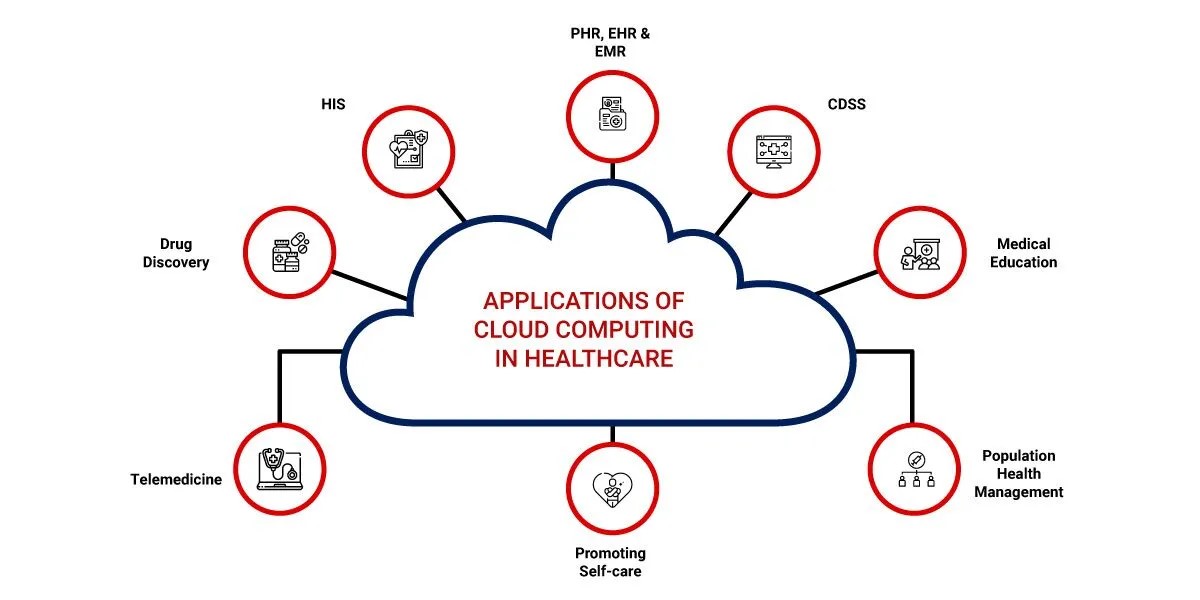The weather is cloudy in the healthcare area.
Many medical providers still prefer to keep their data in legacy electronic health records (EHR). However, when the world moved online during the coronavirus pandemic, EHRs demonstrated their limited abilities. Healthcare organizations searched for a better solution to store and manage their medical and administrative data. Cloud computing provides easy access to information for different stakeholders, convenience in sharing and managing data, and reducing infrastructure and hosting expenses. Statistics tell us that public cloud services will grow at a pace of almost 20% each year until 2029.
The main issue with on-premise EHRs is that they cannot deliver a smooth patient experience across several clinics or medical centers. It makes patients wait for vital information and lose precious time. Healthtech companies can change the game. In this post, Belitsoft experts share their experience with cloud-based healthcare solutions.
What is cloud-based healthcare?
The cloud serves as digital storage for the data. Patients, doctors, and healthcare business owners can access that storage at any time and use the information they need. Non-cloud storage implies hardware or internal servers.
At the same time, there is no need to eliminate EHRs when applying cloud computing. Those systems become integrated into the cloud. As a result, physicians can view the results of lab tests, refer to X-rays or MRIs, and deliver detailed diagnoses.
Medical billing and documentation also become easier with cloud solutions. A proper API consolidates the data from the call center, marketing, and financial departments and allows employees to process it simultaneously.
Developers often use the .NET technology for building healthtech solutions. The chief innovation officer at Belitsoft, Dmitry Baraishuk, notes that the .NET Core meets all the requirements for a user-friendly cloud-based solution. Healthtech businesses convert .NET Framework to .NET Core for the following reasons:
- cross-platform capabilities attract a wider scope of customers to the healthtech products;
- easy customization allows for tailoring a solution to clients’ needs;
- solutions become compatible with third-party libraries and applications;
- ASP.NET Core framework reduces the number of servers and virtual machines used, which leads to cutting infrastructure and hosting costs.
Addressing a healthtech company holds another advantage for a medical provider. IT partners offer qualified help from their outsource teams. Medical centers and clinics often do not have sufficient resources to hire competent IT staff. That is why clinics form long-lasting partnerships to safeguard their digital transformations. For example, in 2019, the Mayo Clinic in Minnesota announced a 10-year-old collaboration with Google. During this period, the tech giant will lead and maintain digital transformations in the clinic. The innovations will include cloud computing tools, data analytics, and the possibilities of artificial intelligence (AI). Such an approach guarantees a full cycle of migration, with iterative testing at every stage and careful analysis of the efficiency of the new software.
What are the advantages of cloud-based solutions?
Medical organizations have many data sources that add to the general dataset. The information comes from clinics, physicians, insurance firms, etc. Attempts to find exact pieces of information might be time-consuming and, therefore, frustrating for both patients and employees. Further are the benefits of cloud-based systems for all parties:
Teamwork
In the agenda insights for healthcare providers published by Gartner, it was mentioned that 92% of businesses plan to leverage distributed cloud technologies by 2025. Distributed clouds unify the data from multiple providers and on-premises datasets. For a patient, that means information about their laboratory tests, images, and other health history will be available at any medical center or clinic. Patients will not be tied to a particular location and will have a choice.
Cloud technologies also simplify the work of the call center agents. They can see the slots in doctors’ schedules and instantly make appointments. Similarly, administrative staff check the patients’ insurance coverage to see if prior authorization is required for a recommended procedure. Access to cloud storage accelerates the process.
Patient engagement
Another study by Gartner says that 20% of medical enterprises will shift to digital front-door platforms by 2026. Those are applications that allow patients to control their healthcare experience. Patients can make appointments online, monitor test results, share images with clinicians, and receive consultations.
Medical cooperation
Patients usually have a combination of symptoms. Cloud solutions help physicians, surgeons, radiologists, and other experts share their diagnoses and decide on the most appropriate treatment plan. The data is updated regularly, which means colleagues might double-check each other and reduce errors. Moreover, it ensures uninterrupted care even if a patient decides to switch providers.
Cloud + AI = satisfied clients
Supplementing cloud-based solutions with AI features brings medical centers to the forefront line of the competition. For instance, AI chatbots aid medical staff in solving many routine tasks, including:
- virtual assistants gather common symptoms and make relevant appointments;
- virtual psychologists support patients suffering from insomnia, depression, or relationship crises;
- AI tools analyze the most common information requests regarding working hours and lab results status, as well as complaints on the website, and therefore provide insights for marketing departments;
- bots can perform triage and refill prescriptions online.
Safety issues and solutions
Despite the above-mentioned benefits, many medical providers are reluctant to implement cloud solutions in their corporate systems. The main reason for hesitation is cybersecurity threats. Healthcare has recently become an attractive target for cybercriminals. In 2024, the Black Basta group attacked two organizations in Europe and the USA. The criminals encrypted patient data and demanded a ransom for the decryption. Otherwise, they threatened to leak the data to the Internet. The group is suspected of making over $100 million this way since 2022.
Negligent data usage plus a lack of proper data encryption and APIs are among the main reasons for security troubles, as experts admit. That is why it is vital for healthtech enterprises to draw special attention to their customers’ security measures.
There are different approaches to cloud security:
- Zero-trust authentication means that the system trusts neither employees nor visitors. Each user passes a validation procedure and is assigned access rights depending on their request.
- Detection and response systems analyze users’ activity and notify them of any unusual behavior.
- Security information and event management (SIEM) allows security experts to identify an attack quickly and react immediately.
Wrap up
Experts from Deloitte believe that healthcare businesses should switch the focus from treatment to customers’ well-being. In other words, patients should feel satisfied not only inside hospitals or clinics but also happy with the assistance “outside the walls.” Wearable devices, virtual assistants on the website and in the applications, notifications from the clinic reminding of a prescription refill or a check-up date – all those features are available with cloud-based software. Integration of them into healthcare leads to increased levels of service and medical progress in general.



